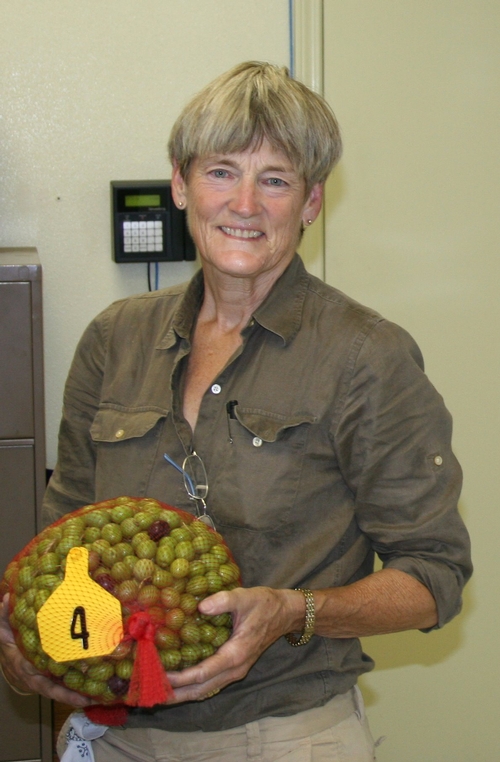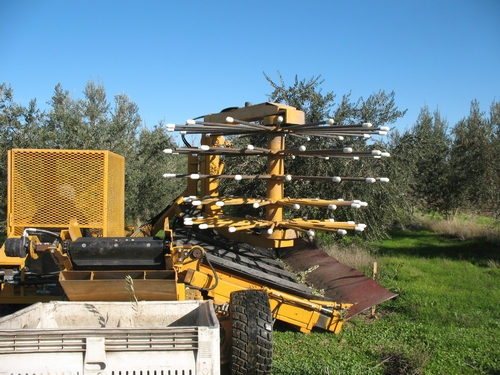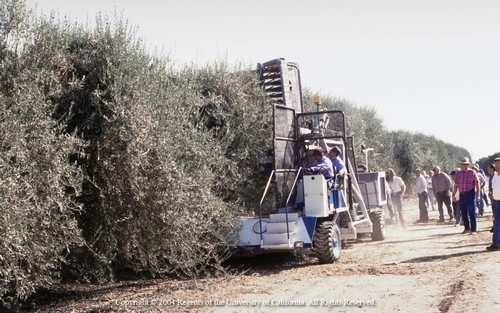Posts Tagged: mechanical
Keeping olives on the table
![3505 Plate 01 03[1] 3505 Plate 01 03[1]](http://ucanr.org/blogs/food/blogfiles/5202.jpg)
“That’s a ridiculous equation,” says Dennis Burreson of Orland, grower and chairman of the research committee of the California Olive Committee. “We can’t survive if we’re spending more than half our gross returns on labor.”

“I think mechanical harvesting will soon revolutionize the table olive industry,” said Ferguson, pomologist with the UC Davis Department of Plant Sciences and director of the UC Davis Fruit & Nut Research and Information Center.
Mechanical harvesters are commonplace for countless commodities, including olive oil olives. What is it about table olives that make them so hard to mechanically pick?
They bruise easily, for one thing, and bruised olives don’t cure well. Plus, table olives are harvested while still immature – unlike the more mature olive oil olives – so it takes more force to knock them off the tree. And then there is the tree canopy: Table olives trees tend to be wispy, less accommodating to mechanical harvesting than the high-density hedgerows you see in olive oil orchards.
Visit a typical table olive orchard and you will see the problem. It’s hard for a mechanical shaker to clean fruit off a tree that just sways, especially when that fruit is hard to dislodge in the first place. Plus, olive tree trunks get knobby with age (like the rest of us). If a machine rubs the bark off those knobs, it opens the tree to disease.
Scientists and engineers have been trying for decades to come up with a viable mechanical harvester. As with earlier attempts, a few versions designed and tested in the mid-90s didn’t pan out because they didn’t remove and capture enough high-quality fruit. But more recent efforts are showing great promise.

The two leading picking technologies are “canopy contact harvesting heads” (it resembles a huge hair brush) and trunk shakers. The canopy contact harvester can be used in existing orchards when they are pruned into a hedgerow and can also be used in the new high-density orchard Ferguson and her team designed, modeled after olive oil orchards. The trunk-shaking technology can be used in new high-density orchards but not in conventional orchards.
And here is the good news on fruit quality, the piece of the puzzle that now makes mechanical harvesting so promising: Even trained testers couldn’t tell the difference between manually and mechanically harvested table olives.
“That’s huge because fruit quality had always been a sticking point,” Ferguson says. “Jean-Xavier Guinard (sensory scientist with the UC Davis Food Science and Technology) worked with an expert panel trained to detect even the slightest defect in texture, taste, aroma – the works. They detected virtually no different between olives that were manually and mechanically harvested.”
More taste tests with both expert and consumer panels are in the works. In the meantime, several growers have decided to take the plunge. Burreson, for example, has planted 120 acres of table olives in the high-density hedgerows Ferguson helped design. In about five years, his olives will be ready for harvest.
So keep your fingers crossed as you enjoy your table olives, figuratively if not literally. It’s hard to keep your fingers crossed if eat them the old-school way, one at a time off each finger and thumb.
California table olives - An economic dilemma
How do you use California table olives in your family meals? On pizza? In salads? In Mediterranean dishes? As part of your holiday relish trays?
Today, California is the only U.S. state to commercially produce olives. Over 95 percent of production is canned as California-style black-ripe or green-ripe olives.

California table olive (Olea europaea L.) growers rely on the primary ‘Manzanillo’ cultivar. To assure absolute quality, harvesting is done by hand. Using ladders, crews hand-harvest the olives off each branch, tree by tree. There can be 1,000 olives on a tree, so each crewmember can pick only two or three trees a day. Hand harvesting expenses account for roughly 45 to 60 percent of gross return for growers; and increasing labor costs adversely affect California’s global competitiveness in the table olive market. This is an unsustainable economic situation. California olive growers cannot survive spending more than half their gross incomes on harvest labor.
To help California olive growers deal with this economic dilemma, UC Cooperative Extension specialist Louise Ferguson and her team of research collaborators are focusing on the mechanical harvest of table olives, thus relieving the growers’ total dependency on the costly and shrinking numbers of available hand laborers.
Mechanizing the harvest of table olives presents some unique challenges. The tree canopy and trunk must be adapted to interface with the harvester, avoiding damage to the tree, and the fruit must be collected with minimum bruising. Mechanical harvesting is particularly difficult with table olives. Tree trunk damage, bruised fruit and poor removal efficiency have limited its acceptance.
New technologies have been developed to address these problems: trunk shakers and canopy contact harvesting heads. The most limiting factor, fruit damage, has been eliminated. The trunk shakers can be used in new high-density orchards developed by Ferguson and her team. The canopy harvester can be used in existing orchards if trees are pruned into hedgerows and in the new high-density orchards.
“I think we’ve turned the corner on mechanical harvesting of table olives,” Ferguson says. “And that makes me happy. Table olives are a traditional California crop – they came here with the early Franciscian missionaries. I would hate to see California growers lose their locally-grown advantage in the table olive market. We could actually see a resurgence in the industry.”

Olive trunk shaker

Olive canopy contact harvesting head
Taking the drudgery out of weed control
For automated, mechanical weed control to work, scientists must teach machines how to distinguish between unwanted vegetation and the crop being cultivated. A new, high-tech system using x-rays to detect tomato stems is under development by UC Davis Cooperative Extension agricultural engineer David Slaughter and USDA Agricultural Research Service researcher Ron Haff. The output from the x-ray detector is input to a microcontroller that controls a pair of pneumatically powered mechanical weed knife blades.
Slaughter and Haff's work was explained this week in an online newsletter produced by Vision Systems Design, an organization that provides automation solutions for engineers and integrators worldwide.
The mechanical weeding machine includes an x-ray mounted to the side of a shielded tunnel that is pulled behind a tractor over the row of tomato plants. As the x-rays radiate across the tunnel, they are detected by an array of 32 photodiodes whose output is tied to a single point at the input of a summing amplifier, the story says.
The system was used in field trials on a 15-meter row containing 39 standing tomato seedlings. At a speed of about 1 mile per hour, the detection system identified all 39 stems of standing plants with no false positives.

Tomato field infested with field bindweed.